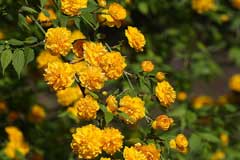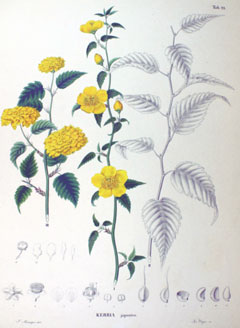 |
|
http://commons.wikimedia.org/wiki/User:Ignis |
 |
| http://commons.wikimedia.org/wiki/File:Kerria_japonica_SZ98.png |
Translate this page:
Summary
Bloom Color: Yellow. Main Bloom Time: Early spring, Late spring, Mid spring . Form: Spreading or horizontal, Upright or erect, Weeping.
Physical Characteristics

 Kerria japonica is a deciduous Shrub growing to 2 m (6ft) by 2 m (6ft) at a medium rate.
Kerria japonica is a deciduous Shrub growing to 2 m (6ft) by 2 m (6ft) at a medium rate.
See above for USDA hardiness. It is hardy to UK zone 4. It is in flower from April to May. The species is monoecious (individual flowers are either male or female, but both sexes can be found on the same plant) and is pollinated by Insects.
Suitable for: light (sandy), medium (loamy) and heavy (clay) soils, prefers well-drained soil and can grow in heavy clay and nutritionally poor soils. Suitable pH: mildly acid, neutral and basic (mildly alkaline) soils. It can grow in semi-shade (light woodland) or no shade. It prefers moist soil.
UK Hardiness Map
US Hardiness Map
Synonyms
Plant Habitats
Woodland Garden Dappled Shade; Shady Edge;
Edible Uses
Edible Parts: Fruit Leaves
Edible Uses:
Young leaves - cooked[105, 177]. The leaves contain a small amount (0.002%) of hydrogen cyanide and are also a rich source of vitamin C (200mg per 100g)[218]. Some caution is advised, see the notes above on toxicity. Fruit[177]. No more details are given, but this report is somewhat suspect, the plant does not produce a fleshy fruit and the seed case certainly does not look edible[K]. The fruit is a dry, somewhat plump achene about 5mm in diameter[200].
References More on Edible Uses
Medicinal Uses
Plants For A Future can not take any responsibility for any adverse effects from the use of plants. Always seek advice from a professional before using a plant medicinally.
Vitamin C Women's complaints
A decoction of the flowering shoots is used in the treatment of coughs and women's complaints[178, 218].
References More on Medicinal Uses
The Bookshop: Edible Plant Books
Our Latest books on Perennial Plants For Food Forests and Permaculture Gardens in paperback or digital formats.

Edible Tropical Plants
Food Forest Plants for Hotter Conditions: 250+ Plants For Tropical Food Forests & Permaculture Gardens.
More

Edible Temperate Plants
Plants for Your Food Forest: 500 Plants for Temperate Food Forests & Permaculture Gardens.
More

More Books
PFAF have eight books available in paperback and digital formats. Browse the shop for more information.
Shop Now
Other Uses
References More on Other Uses
Cultivation details
Landscape Uses:Container, Foundation, Pest tolerant, Massing, Specimen. Succeeds in most aspects in any good loamy soil[1]. Succeeds in very poor soils[202]. Grows well in heavy clay soils. Prefers a moist well-drained soil in a sunny position with shade from the midday sun[200]. Hardy to about -20°c[184]. Plants are moderately fast growing[202]. They sucker freely and can be invasive[202]. Some named forms have been developed for their ornamental value[182]. This species is notably resistant to honey fungus[200]. The flowers are said to be usually unisexual but we do not know if the plants are dioecious or monoecious. Special Features:
Not North American native, Attractive flowers or blooms.
References Carbon Farming Information and Carbon Sequestration Information
Temperature Converter
Type a value in the Celsius field to convert the value to Fahrenheit:
Fahrenheit:
The PFAF Bookshop
Plants For A Future have a number of books available in paperback and digital form. Book titles include Edible Plants, Edible Perennials, Edible Trees,Edible Shrubs, Woodland Gardening, and Temperate Food Forest Plants. Our new book is Food Forest Plants For Hotter Conditions (Tropical and Sub-Tropical).
Shop Now
Plant Propagation
Seed - we have no details on this species but suggest sowing the seed as soon as it is ripe in a cold frame. Sow stored seed as soon as possible in a cold frame, it is likely to require a period of cold stratification. When they are large enough to handle, prick the seedlings out into individual pots and grow them on in the cold frame for their first winter. Plant them out into their permanent positions in late spring or early summer, after the last expected frosts. Division of suckers, removed with care from established plants during the dormant season[200]. Larger clumps can be replanted direct into their permanent positions, though it is best to pot up smaller clumps and grow them on in a cold frame until they are rooting well. Plant them out in the spring. Cuttings of young shoots. Young basal shoots in early summer work quite well. Harvest the shoots when they are about 10 - 15cm long with plenty of underground stem. Pot them up into individual pots and keep them in light shade in a cold frame or greenhouse until they are rooting well. Plant them out in the summer. Layering.
Other Names
If available other names are mentioned here
Native Plant Search
Search over 900 plants ideal for food forests and permaculture gardens. Filter to search native plants to your area. The plants selected are the plants in our book 'Plants For Your Food Forest: 500 Plants for Temperate Food Forests and Permaculture Gardens, as well as plants chosen for our forthcoming related books for Tropical/Hot Wet Climates and Mediterranean/Hot Dry Climates. Native Plant Search
Found In
Countries where the plant has been found are listed here if the information is available
Weed Potential
Right plant wrong place. We are currently updating this section.
Please note that a plant may be invasive in one area but may not in your area so it’s worth checking.
Conservation Status
IUCN Red List of Threatened Plants Status :

Growth: S = slow M = medium F = fast. Soil: L = light (sandy) M = medium H = heavy (clay). pH: A = acid N = neutral B = basic (alkaline). Shade: F = full shade S = semi-shade N = no shade. Moisture: D = dry M = Moist We = wet Wa = water.

Expert comment
Author
(L.)DC.
Botanical References
11200266
Links / References
For a list of references used on this page please go here
Readers comment
© 2010, Plants For A Future. Plants For A Future is a charitable company limited by guarantee, registered in England and Wales. Charity No. 1057719, Company No. 3204567.